When
I was first told by by my vet that I needed to pluck an Old
English Sheepdog's ear hair, I know I made a face. "Oooh...
but it's going to hurt." He flipped up the ear flap on
the puppy, pinched a couple of hairs
between his thumb and index finger and quickly plucked it out.
He put the ear flap back down. That particular dog never
flinched. That was my introduction to the process of plucking
ear hair.
Ear Plucking... some dogs tolerate the process very well. Others hate having it
done and may require sedation by a veterinarian so the hair can be
professionally removed.
This is why it's important to get the puppy or dog to view this
process as tolerable. The way I've desensitized my Old English
Sheepdog puppies to ear plucking is during their "introduction to
grooming". Even my Old English Sheepdog that arrived at close to 11
months of age went through this same process. It involves
brief play grooming sessions each evening. I think many dogs look
for, "What's in it for me?". All of my dogs are food motivated
so it makes things easier. Play grooming... treats... play
grooming.... treats... play grooming... treats... etc.
The first time I pluck a
dog's ears, I flip an ear flap (also known as the pinna), pinch
maybe 2-3 hairs and quickly remove it. I give the dog a treat
immediately after plucking the hair so he or she associates the
action with "something good is going to follow". We then go
back to play grooming. I go to the other ear a little later do
the same thing and that's it for the day. It doesn't appear
that much has been accomplished but if you play groom every evening,
it can add up over a month or two. I slowly add a couple more
hairs to each pluck as days goes by but only if the dog has been
tolerating it well.
|
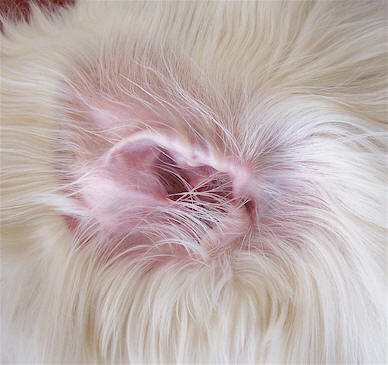
Before |
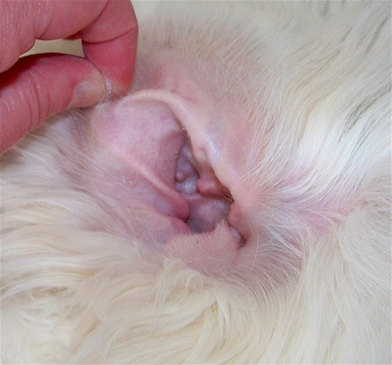
After |
|
What
You're Trying To Accomplish...
Above is an example
of an Old English Sheepdog's ear before being plucked and after. The reason for
plucking the hair from an Old English Sheepdog's ears is to
improve airflow, make cleaning easier and to reduce the risk of
infection from bacteria or yeast. Ears that don't have
plugs of hair in them will dry out faster too. The hair is plucked from
both inside the ear canal and from the ear flap near the ear
opening using my fingers. I use a battery operated palm clipper on the
ridge in front of the ear opening.
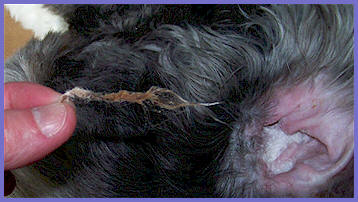
This is an
example of what can be found inside an Old English Sheepdog's
ears. It's a waxy clump of hair that was
removed with my fingers from deep in
the ear canal. Hair left in
the ears tends to collect wax and it can limit air flow.
|


|
This
is simply the ear care
product I use. There are
many others... use the product(s) you feel works best.
Some people
prefer to use tools to remove ear hair... I choose to use my fingers instead.
I don't have to worry accidentally injuring the dog if he
suddenly jumps because someone's at the door. I surely don't have the most beautiful hands
but my short nails won't cause a dog any harm either.
You will need to be careful if you do have longer finger
nails.
-
Bio-Groom
Ear-Fresh Astringent Ear Powder
Use: Ear powder allows you to get a better grip on the
hair your trying to remove.
-
If your
dog is prone to ear infections,
speak with your vet about
the best products to use. Ask whether
applying an ear antibiotic immediately
after plucking might help to prevent ear infections due
to bacteria. These products usually requires a prescription.
Caution: One drug in particular that
I've used is said to cause hearing loss- Mometamax.
https://www.drugs.com/vet/mometamax-otic-suspension.html
https://deafdogsrock.com/be-aware-of-the-risks-when-treating-your-dog-with-mometamax
-
I wait at least a couple of days
for the plucked ear tissue to settle down before using any ear
cleaner with alcohol in it because it would sting.
If ears are waxy, I will use an alcohol-free solution
and a cotton ball to wipe the
ear flap and outer ear canal area down. Choose an
ear cleaner that's less likely to sting like Pfizer Oti-Clens or Butler Euclens Otic Cleanser.
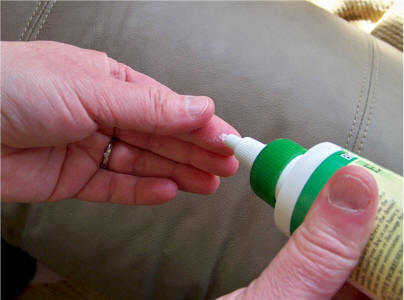 |
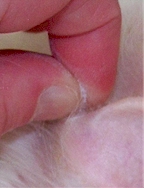
Ear powder
between the
thumb and index finger
plucking hair from ear flap. |
The Technique (for the dog with the
white ear)... I've been
known to get a little carried away with ear
powder (see the dog's ear below and in
the
other photo demo). If the dog's ears are
particularly greasy/oily and there's lots of
hair, it's best to
use the "puff" method to dispense
the powder. On dogs with less profuse
ear hair, rather than
"puffing" the powder on the ear hair, I
sometimes put a small amount on my index
finger and press my thumb into it.
It's just enough to give me the grip I need
to pluck the hair. I repeat this as
needed.
|
Plucking is a
quick, decisive act... not a slow, pulling motion.
It does NOT need to be lavish or exaggerated though. You
don't want to excite or distress the dog.
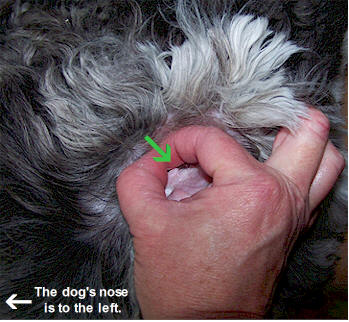

Before Beginning...
I inspect the
ears to see if they are unusually dirty or for signs of infection
like redness, yeast or drainage. If the ears are dirty,
I thoroughly clean them out and wait a couple of days to
pluck them. If any infection or unusual odor is noted, I will
not pluck the ears. I address the problem with a visit to the
vet and wait until the ears are again healthy.
If the ears look good,
I gather up my supplies
and treats if the dog is less tolerant. I have the dog get up on the grooming table
or I sit next to them on the floor, couch or bed.
I have the dog lie on his/her side and give the dog a treat... I
then go to work. NOTE: I give a treat with the hand I'm
not
using to remove ear hair!
|
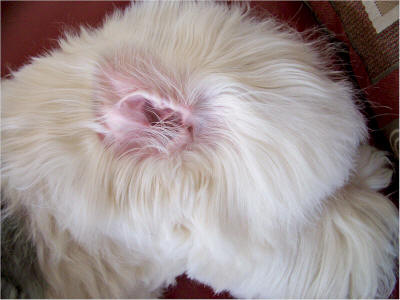
I first comb
out the ear hair away from the ear opening and make sure
there is no infection. If I find an infection, I
will not proceed with the ear plucking.
|

The area
inside the green box is the area I focus on first...
it's the front of the ear opening. Note that I do
not pluck the hair in this area. Instead, I use a palm clipper to trim it shorter.
|
|
Clipper Tips

-
Before trimming for
the first time, get to know how your dog's ears were created.
-
Glide the clipper blade over
the skin, don't apply pressure or you could cause painful razor
burn.
-
Keep the blade level with the
skin as you shave so you don't cut skin. Use extra care
when there are narrow or raised areas of skin like the raised
area in front of the ear opening.
-
You could also use
scissors if you do not have clipper.
-
If you use a
standard electric clipper and a #10 blade, be sure the blade is
cool before trimming this sensitive area.
|
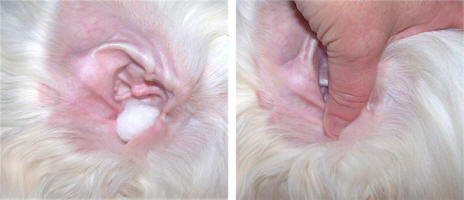
Note: The
hair has already been shaved off and plucked so you can
see the process more clearly.
I use a
battery operated palm clipper on the front area of the
ear opening (inside the green box above). I either
cover the ear opening with my thumb or a cotton ball or
I trim away from the opening to prevent the hair
clippings from falling inside the ear canal. Pick off any
loose hair before removing the cotton ball or your
thumb.
|
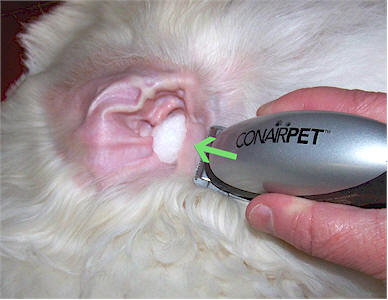
This picture shows the direction
I glide the clippers.
No need to apply pressure as you clip... you're just
removing
the tufts of hair so there will be better airflow. |
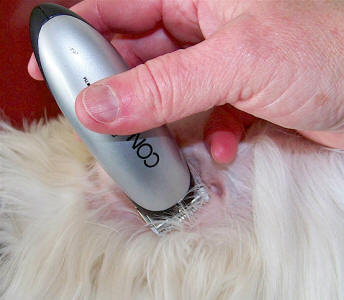
You can also trim away from the
ear opening if you're
careful to avoid the outer ridge/edge of the ear opening.
You never want it to come into contact with the clipper
teeth. |

I then pluck the hair within the green area
and inside the ear canal using my fingers. |

I grasp
a small amount of hair and pluck
it in the direction the hair grows. If a dog is real
sensitive, I'll only pluck a couple of hairs at a time
because it's always best to maintain the dog's trust.
The job does not need to be completed in one sitting.
The idea is to get the dog to willingly tolerate the
process, not dread it.
|

Almost done... just plucking
some of the hair from the ear flap. |

This ear is all done!
I then do the same thing with the other ear. |
I take a quick
look in the ears over the next couple of days after plucking
them to be sure there's no sign of infection or irritation.
I'll clean the ears with one of the alcohol-free ear
cleaners previously mentioned if they look a little
irritated. I'll wait a couple of days before using the
usual K-9 Liquid Health Ear Solution that contains alcohol.
This Old English Sheepdog's ears are very easy to maintain.
She doesn't mind the process as long as there's a reward at
the end of the plucking session.
Some dogs have a lot more ear hair and don't care much for
the process.
Click here for one such dog.
|







